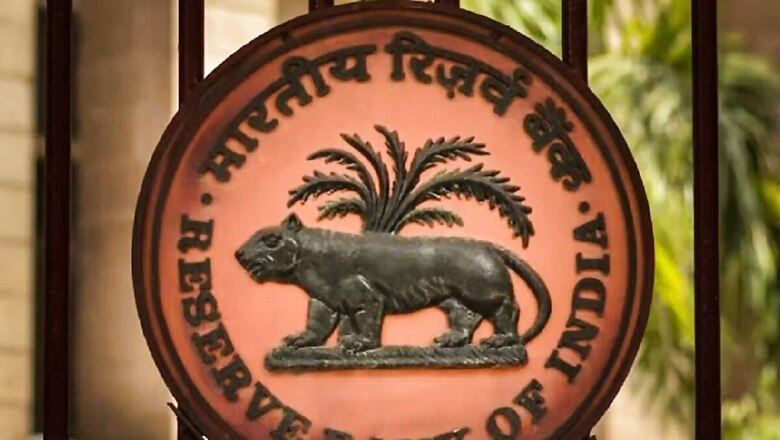
views
The Reserve Bank of India’s (RBI) decision to declare its highest-ever dividend of Rs 2.11 lakh crore for 2023-24 evoked mixed reactions from economists.
The dividend or surplus transfer by the RBI to the Centre was Rs 87,416 crore for the fiscal 2022-23. The previous high was Rs 1.76 lakh crore in 2018-19.
While noted economist Suman Mukherjee hailed it as a sign of economic strength, Abhirup Sarkar expressed worries that the dividend could restrict the RBI’s ability to rescue lenders in future as the central bank might not have enough money to step in immediately.
“This is not a fluke,” Mukherjee told news agency PTI, attributing the windfall to a confluence of factors including a surge in foreign exchange reserves, loans to commercial banks and the government’s proactive approach in managing contingencies.
He highlighted that the positive impact of RBI development is evident on the stock market ending in a record high.
Mukherjee downplayed concerns about rising interest rates, suggesting that focus on maintaining low rates will counter potential recessionary effects.
However, Abhirup Sarkar, another noted economist and a former professor at the Indian Statistical Institute, expresses reservations.
Sarkar questions the government’s motives, suggesting that deficit reduction might be a primary driver.
He also stated that the payment might not be from its income and the central bank could have used its reserves to pay the hefty dividend.
He cautions against inflationary risks and a decline in real interest rates impacting certain segments.
Sarkar told PTI, “Dividends would also enable the government to borrow less from the market, potentially reducing borrowing costs and stimulating corporate investments.”
However, he cautioned against the inflationary impact of injecting liquidity into the market, foreseeing a decline in real interest rates that could adversely affect retirees and individuals reliant on interest income.
Sarkar’s primary concern centres around the potential weakening of the RBI’s financial strength and independence.
Sarkar, a former chairman of the 5th West Bengal State Finance Commission, raised concerns about the RBI’s record dividend weakening the institution.
“RBI needs war chests for emergencies, like rescuing troubled banks,” says Sarkar, highlighting the importance of reserves.
He expressed worries that the dividend could restrict the RBI’s ability to rescue banks in the future as the central bank might not have enough money to step in immediately.
“It may limit the ability to manage liquidity through open market operations and forex interventions to stabilise the Rupee in the future,” the economist said.
Sarkar feared the government was undermining the RBI’s independence.
He was sceptical about the government’s actions, emphasising the need to safeguard the autonomy and efficacy of the RBI in maintaining financial stability.
Rating Support if India Uses RBI Dividend to Reduce Fiscal Deficit
India can get ‘rating support’ over time if it utilises the highest-ever dividend of over Rs 2 lakh crore received from the Reserve Bank to reduce fiscal deficit, said an S&P Global Rating analyst on Thursday.
“The additional dividends from the RBI are around 0.35 per cent of GDP. Whether it would support the narrowing of the fiscal deficit in fiscal 2024-25 would really depend on the final budget that would be passed after the June election results,” S&P Global Ratings Analyst YeeFarn Phua told PTI.
The additional dividend from the RBI may not necessarily lead to a full decrease in the deficit due to potential revenue shortfalls in areas like divestment receipts or additional allocation to expenditures in the final budget, Phua said in an email interview from Singapore.
However, “if it does lead to a full decrease of the deficit, we believe it will lead to a faster path of fiscal consolidation that, in turn, will provide rating support over time”, Phua added.
In May last year, S&P Global Ratings affirmed India’s sovereign rating at ‘BBB-‘ with a stable outlook on growth but flagged weak fiscal performance and low GDP per capita as risks.
‘BBB-‘ is the lowest investment grade rating.
All three global rating agencies — Fitch, S&P and Moody’s — have the lowest investment grade rating on India with a stable outlook. The ratings are looked at by investors as a barometer of the country’s creditworthiness and impact on borrowing costs.
RBI Gives Dividend To Government
The Reserve Bank on Wednesday approved the highest-ever dividend payout of Rs 2.11 lakh crore to the central government for 2023-24.
The dividend or surplus transfer by the RBI to the Centre was Rs 87,416 crore for the fiscal 2022-23. The previous high was Rs 1.76 lakh crore in 2018-19.
The decision on the dividend payout was taken at the 608th meeting of the Central Board of Directors of the Reserve Bank of India held under the chairmanship of Governor Shaktikanta Das.
The central government aims to contain the fiscal deficit or gap between expenditure and revenue to Rs 17.34 lakh crore (5.1 per cent of the GDP) during the current financial year.
In the Budget for 2024-25, the government projected a dividend income of Rs 1.02 lakh crore from the RBI and public sector financial institutions.
The RBI board also reviewed the global and domestic economic scenario, including risks to the growth outlook.
The Board discussed the working of the Reserve Bank during 2023-24 and approved its Annual Report and Financial Statements for the last fiscal.
The RBI said that during accounting years 2018-19 to 2021-22, owing to the prevailing macroeconomic conditions and the onslaught of the Covid-19 pandemic, the Board had decided to maintain the Contingent Risk Buffer (CRB) at 5.50 per cent of the Reserve Bank’s balance sheet size to support growth and overall economic activity.
“With the revival in economic growth in FY 2022-23, the CRB was increased to 6.00 per cent. As the economy remains robust and resilient, the Board has decided to increase the CRB to 6.50 per cent for FY 2023-24,” the central bank added.
The transferable surplus for 2023-24, the RBI said, has been arrived at on the basis of the Economic Capital Framework (ECF) adopted by it in August 2019, as per recommendations of the Bimal Jalan-headed expert committee.
The committee had recommended that the risk provisioning under the CRB be maintained within a range of 6.5 to 5.5 per cent of the RBI’s balance sheet.
(With PTI inputs)



















Comments
0 comment